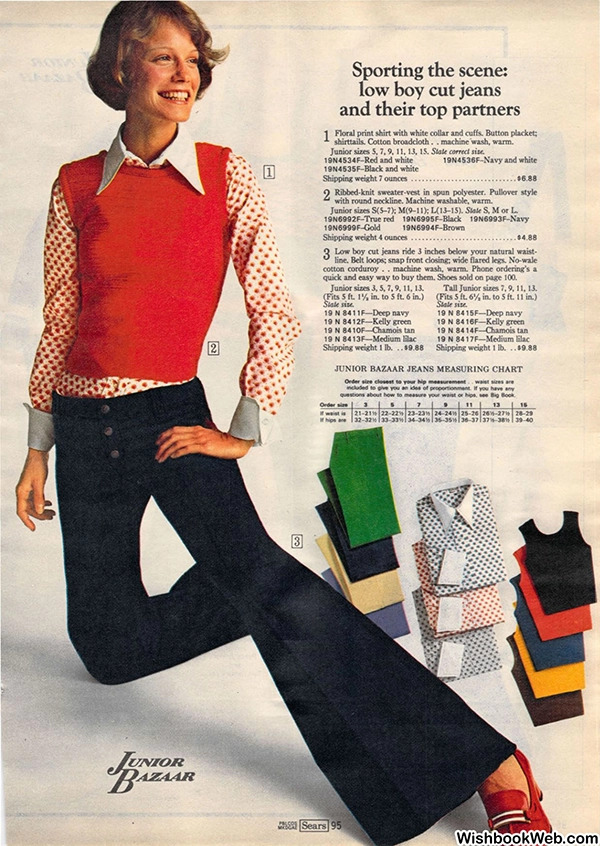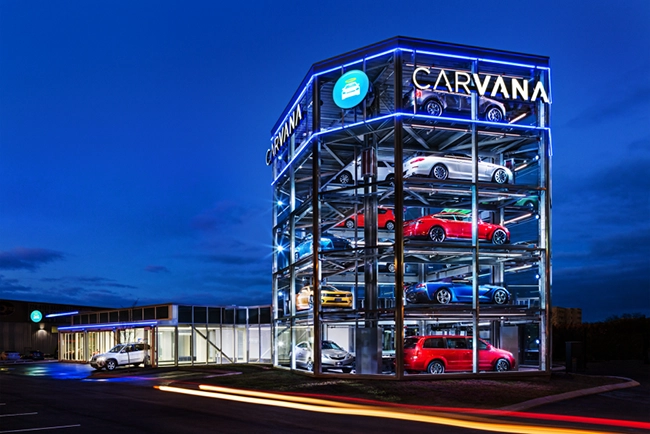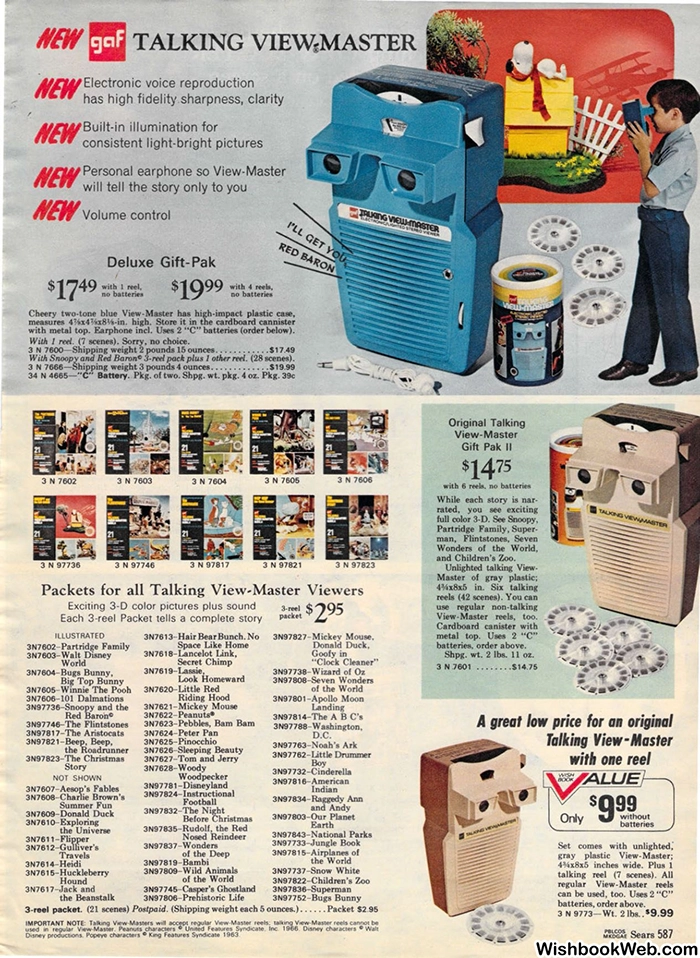LINKS
- Attack of the 50-Year-Old Comics
- Super-Team Family: The Lost Issues
- Mark Evanier's Blog
- Plaid Stallions
- Star Trek Fact Check
- The Suits of James Bond
- Wild About Harry (Houdini)
Well, here we are at Christmas time again (!) so let’s take another look at what was available to American consumers fifty years ago via the miracle of the full-color, 602-page Sears catalog as preserved at wishbookweb.com. Set your digital alarm clock for 1972 and we’ll wake up in the groovy past…

What’s that you ask? How can it be a “digital” alarm clock if it’s got no computer elements and no LED display, just gear-driven rotating dials with numbers printed on them? Simple: “0” to “9” are all “digits.” Duh. As far as that goes, if you count on your fingers, well then you have a digital calculator, yes? Notice these models are from a line called “The Readables.” Presumably this means there are cheaper versions where the display can’t be clearly interpreted. And that’s okay in the groovy 70s: as Chicago sang two years earlier, “Does anybody really know what time it is? Does anybody really care?”
Indeed, here in 1972 we have very few cares. Everyone dresses in bright colors and bold patterns and even if we step in the mess left by the neighbor’s dog, we just laugh it off.

Our bell bottoms are wide enough to hide a pony behind, our shirt collars are as big and potentially aerodynamic as the Flying Nun’s hat and our sweater vests are often three sizes too small, but do we let that get us down? Of course not. Well anyway, not if we’re Shelly Hack of Charlie’s Angels fame.

Of course it’s not all sunshine and lollipops. The internet hasn’t been invented yet and we have to wait halfway through the TV news to get to the weather forecast, so we’ve taken things into our own hands and filled the house with a full collection of scientific weather instruments including barometers, thermometers and hygrometers so we know which of our many tasteful outfits to wear when we head out…

Which is great because we’ve got so many fun places to go, like that party over at the Hendersons, where we can join a half dozen of our friends and neighbors, all sticking chunks of meat and veggies into a shared fondue pot. Yum! There’s no masks or hand sanitizers in 1972, baby. It’s share and share alike.

Not that most of this would have mattered to me at the time, as I was just 7 years old. All of the above was just stuff to quickly thumb through on my way to the back end of the catalog, where I could find the toys. Leading off is a bike with the same general design as the ones my brother Tim and I owned, only ours weren’t the 5-speed model.

That banana seat design really was more comfortable than an old-school bike seat. I remember being perplexed by the chrome “handle” thing in the rear, which seemed to invite trouble-makers to grab it and bring you to a screeching halt. From this photo, I can see it’s just the upper end of a “heavy duty support bar,” without which I imagine that banana seat would soon give way and send you tumbling backward off the bike. The U-shaped handlebars seemed ideal for taking on additional passengers, and I remember convincing a neighbor girl that she’d be perfectly safe riding up there. However as it turns out, it’s really hard to see where you’re going with another kid sitting in front of you, and in the end neither of us emerged from that experiment unscathed.
From there we’re onto toys proper, and the girls get to go first because, you know, chivalry.
I never quite understood the appeal of baby dolls to little girls. Babies are a lot of work, so how could it be “fun” to pretend to be a harried, grown-up Mom, feeding, changing and otherwise caring for an infant? Fortunately, Sears has a clever alternative in the form of “Gramma” and “Grampa,” miniature effigies of senior citizens, so girls can imagine themselves even further in the future to get in some practice at elder care.

It must have been tough to be a girl in 1972. All the “boy toys” revolved around wish fulfilment and fantasy: You could play at being a cowboy or a soldier or a race driver or a train engineer. Meanwhile all the girl toys trained you for a future as a housewife, cooking and cleaning and sewing and caring for babies. I can kind of see the appeal of a toy stove, I guess, especially the Easy-Bake oven that actually delivered up treats you could eat. But a toy dishwasher seems to be taking things way too far.

Arguably, some of the “boy’s toys” were “job-oriented” too, but I don’t know, they just seemed cooler to me, like these construction vehicles. That “jumbo crane” is somewhere in my garage even now, though I was convinced it was a Tonka product (I don’t even remember “Nylint”). Pretty sure we also had that “elevating scraper,” though it’s long gone, now. I can’t say I’ve ever harbored a desire to work in construction, but rolling those things around in a sandbox, lifting and dumping dirt and sand was just plain cool.

There were also toys aimed at learning to read or do math, like this “Magic Answer Machine that’s apparently helping little Billy figure out how spell that word Daddy yelled when he stubbed his toe on the nightstand.

The “board games” section of these catalogs seems to be one of the best places to gage the pop culture zeitgeist of each year, and in the case of 1972, there’s a definite fixation on the supernatural. From memory, this was indeed the case in comic books, television and movies, and here we see 7 out of 12 games veer into the realm of vampires, mummies, ghosts and the Great Beyond.

The only one I had was the “Barnabas Collins Dark Shadows” game, which figures given my youthful fascination with that popular character and show. Alas, aside from the excellent portrait of Collinwood’s favorite vampire on the box art, there wasn’t much of a Dark Shadows connection in the game itself. It came with multiple plastic skeleton parts jumbled up in a cardboard coffin, and the object was to be the first player to fully assemble your skeleton and hang it from a hook. It was a turn-based game, and I think the number of bones you got to attach in each turn was determined by a spinner. As a nice bonus, the skeletons glowed in the dark, which created some play value even if you couldn’t find anyone willing to sit down for the game. I want to say they threw in a set of plastic vampire teeth, but it’s possible the set I had came from somewhere else and I just happened to store it in the box. Anyway as novel as the concept was, it could just have easily been modified to fit a “doctor” theme and teach anatomy (“the thigh bone’s connected to the knee bone”).
Another item still lurking in my garage to this day is the “Checkers/Chinese Checkers” set pictured below. One side of this circular tin featured a checkerboard square for traditional “American” checkers and the other had a star-shaped design with little round divots into which you’d place colored marbles. Over the course of the game, you’d move them to the opposite side of the “board,” jumping other player’s marbles. An appeal was that up to 5 players could compete at once. The checkers and marbles were stored inside the tin which made the whole thing cleverly portable, if far from silent. Rather than play either game, Tim and I were just as likely to put a couple of marbles in the tin and swirl it around at high speeds to make a fun noise.

Also pictured are the “Pop-O-Matic” games, Headache and Trouble. Both came with a pair of dice encased in a plastic dome you’d push on to make a POP sound and “roll” the dice. I’m not sure what the attraction was; maybe the confidence of never losing the dice as you could in other games, maybe the added protection against competitors who you felt were somehow “cheating” with the way they rolled “real” dice by hand. Maybe it was just that popping sound. Anyway they got played a lot at our house.
Up next is the “Computer Garage.” Here you can vertically house multiple die-cast cars and dispense them using a “computer card” in a slot.

This is the kind of thing I would’ve dismissed as a ridiculous flight of fancy in 1972, little dreaming that I’d live to see the infamous “auto vending machines” at Carvana dealerships. I wonder if the designer was inspired by this old toy?

Well before streaming video and Blu-Ray discs, the height of audio-visual entertainment in 1972 was surely the Talking ViewMaster. The usual cardboard disc full of stereoptical images was supplemented here by an attached, tiny plastic record that provided narration. This is another toy I’ve held onto through the years, and it still pretty much works, though the narrator sounds like he’s well into a late-night pub crawl. Maybe he had that same drunken slurring when it was brand new, though, I can’t remember.

Doubtless the star of the show for young me was GI Joe, by now entering his “Adventure Team” phase as the appeal of active combat was shall we say blunted by the realities of Vietnam. Now Joe was spending his time on wild adventures, fighting undersea monsters, unearthing buried treasures, digging up (very short) mummies, you name it.

Of the items pictured here, I had the red-haired Joe and Tim had the brunette, which featured a voice box and could utter various phrases when you pulled his dog tag. Pretty cool, except that meant his chest was the speaker and so it had holes in it, which led to heartache when Talking Joe was submerged in the bathtub for an aquatic adventure. After that he sounded as drunk as the Viewmaster guy. I also had the foot locker and the “deep sea diver” set with that octopus that was way too small to be menacing. We didn’t have the “sea sled” but that dog shark is equally non-threatening.
I never knew how the “Adventure Team” worked. If there was a “team,” did that mean red-haired Joe, brunette Joe and African American Joe were actually three different guys who worked together, and not just variations on the same character? If they were separate individuals, why did they all have identical scars on the same cheek? And the same name? Could you only join the Adventure Team if your name was Joe? And was getting a dueling scar part of the initiation?
The thing with this era of GI Joe is that the figures were 12 inches tall, which allowed for lots of accessory packs with clothes and gear you could change out, but when it came time to put him in a vehicle, it never went great. Jeeps, helicopters, airplanes and submarines always looked ridiculously small with Joe in them, but even so they were big enough to be a pain to move around and store. A few years later, Kenner’s Star Wars line would crack the code as far as this stuff goes, moving to 4.5-inch figures that could more easily fit into properly-scaled vehicles. And if that meant you couldn’t sell outfits to change the figures into, no problem. You could simply start with a “Tatooine” Luke, and if you wanted him to fly his fighter, you went out and bought an “X-Wing pilot” Luke, then when the battle is won, you could buy an “awards ceremony” Luke. Extra outfits brought in profit, but finding a way to sell multiple versions of the same character to deal with every costume change? That was capitalism at its finest.
Anyway, it’s been another fun visit back to the far-out world of Christmas past. Hope this year’s holiday season brings its own fun memories for anyone reading this.